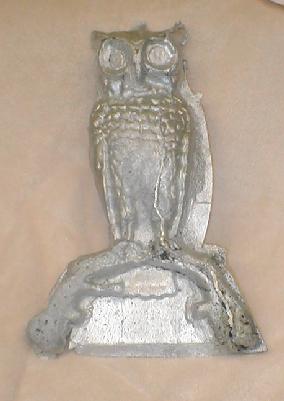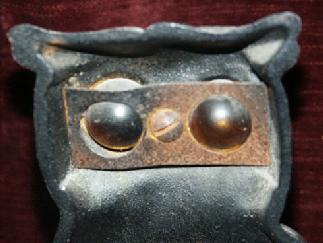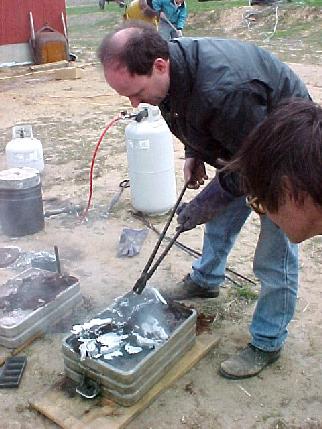Casting an Owl Andiron

This is a story that a pattern maker or foundry sand crab (moulder)
may find interesting. It might not be interesting to anyone else! At
the time I thought that the andirons in question were something unique. I
have since found them on ebay for $14.99 a pair plus $20 in shipping.
There was also an older set on ebay which had a pair of yellow marbles where
the eyes are (back side pictured below). The andirons in question have a hole
in the back between the eyes where something could attach to hold in marbles.
Even though the andirons weren't anything unique the method used to duplicate
them could be used again if similar circumstances ever arise.
I was one of two instructors who taught a small foundry
class
recently. I had taken the class two years earlier.
(Click here to see what I cast then.) Students
help build a charcoal foundry based on Dave Gingery's book.
(It's the first book in a fascinating series
where he builds a machine shop from scratch.)
After the furnace is built, the remaing class time is spent using it
to melt aluminum and brass. I learned two things at the class:
how to build a furnace and that melting brass with charcoal takes a
long time. It took all morning to get the crucible hot enough to
melt brass. When I got home I looked into alternatives. I found a web
page on making a propane burner. The url no longer works but was
http://www.john-wasser.com/NEMES/PropaneBurner.html
The next thing I knew Tiller's asked if I'd like to help teach the class!
(Thanks Mitchell!)
Paul McGuire, the other instructor, has been teaching the foundry class
for a few years.
He shows how a metal five gallon bucket is used as a form for the furnace.
Homemade refractory is rammed into the form. It's built in the morining,
fired in the afternoon and melting metal the following day.
It is capable of melting about a quart of metal.
You wouldn't be able to pour an aluminum engine block but there would be a nearly
infinite number of smaller
things you could cast.
This year an additional day was added to the class making it three days long.
The first day concentrated on pattern making and sand moulding. Once the propane
burner's construction was covered there was great interest in trying it out.
That afternoon and the remaining two
days were spent building and operating a small furnace. As it turned out, it rained on the second day late in the afternoon. Molten metal and water in any form has an
unpleasant tendency to explode. It seemed like a good idea to end a little early.
Tillers, the place where the class was held, has an extensive library containing a wide range of books. I spent some time looking though their collection of foundry books.
There is a large fireplace with glass doors in the library. I noticed a cast iron
owl just outside the fireplace. It was about 8 inches tall and had openings where the
eyes should be. I thought it might be part on an andiron so I opened the fireplace's
glass doors. Inside was a complete andiron and a broken one missing its owl! It
turned out that the owl was supposed to be perched on a curved branch which became
the legs of the andiron. This is where the original owl had broken. The curved branch
was still attached to the broken andiron. A second or two after seeing the complete
owl I decided that I would try to cast a replica. Making another casting from an
existing casting is usually simple.

At first it looked like the owl was
bolted to the rest of the andiron. I borrowed a screwdriver and pliers and removed the four nuts from the unbroken owl. The owl would not separate from the rest of the andiron.
It turned out that there was a weld or braze hidden under a layer of soot. Someone at
some point had welded each owl to its andiron. If this nefarious character had not
done so this story would have been a whole lot less interesting.
One important molding trait is ingenuity. Often there is a way to mould something difficult. It's just a matter of figuring out how to do it.
In this case the easy way out would have been to break the weld. If the owl was separated from the rest of the andiron it would be a trivial matter to cast copies.
It took a little time to come up with a solution. By the next morning I had thought of
a way that might just be crazy enough to work. My idea was to suspend the
complete andiron vertically so the owl would be horizontal. I found a 55 galloon drum
in the blacksmith shop. I used a couple boards that were nearby to hold the andiron
vertically over the 55 gallon drum. The horizontal part where the burning wood would be in
use was then hanging vertically inside the drum. The back legs of the andiron were
also inside the drum. The owl was laying horizontally across the boards- right where
I wanted him. There was about an inch gap between the boards. They were pushed up
tight to the andiron under the owl. The problem was where the horizontal bar attached
to the owl. It is what was causing the gap. I cut a two pieces of sheet metal to fill
this void.

The next step was to get my owl pattern ready to be molded. This would have been
necessary even if the owl had been separated from the rest of the andiron.
It involved filling the eye
openings with modeling clay. If this wasn't done the moulding sand would have
filled the opening. It might have caused a sand avalanche when withdrawing the
owl from the sand. In other words, the impression left in the sand would not be
as faithful a copy of the original as it could have been. The clay was a simple
and standard precaution.
The next few steps were also ordinary foundry practice. A flask was placed around
the suspended owl. Parting dust was applied. Moulding sand was rammed around the
owl filling the flask. The next step was non standard. Ordinarily the two sides
of a pattern are rammed in mating flasks. After both halves are rammed, the flasks
are separated and the pattern is withdrawn. In this case things were very different.
I had to switch patterns in mid steam. I lifted the flask off the suspended
owl. Ordinarily you'd lift the pattern from the sand- not the sand from the pattern.
I then flipped the flask over and placed the broken owl in the owl shaped void left
by the suspended owl. Parting dust was again applied as normal. The broken
owl didn't fill the entire void left from the suspended owl. Parting dust was
applied to this area. The intent was to get a clean pull where moulding sand
would fill this void and create a corresponding hump in the other flask.
I would have to remove some of the hump so the metal would flow into this
area.
The next few steps would be normal: A second flask was placed over the
first one and moulding sand was rammed in. The flasks were separated and the
broken owl pattern was withdrawn. Originally I had planned on carving down the
sand that filled the void below the broken owl's feet- where the curved branch
void was. This would have created the same shape as an intact owl would have.
What happend was that the molding sand remained in the void- in the wrong half
of the flask. I had to remove this sand- not doing so would have produced a
branchless casting. It was a simple matter to carefully dig out this sand
until I could see the parting dust I had applied before. At that point I had
an owl shaped cavity when the flasks were rejoined. This would have been
similar to the cavity at the foundry when the owl was originally cast.
The
last steps were ordinary. The flasks were vented and a sprew and riser were
cut. A quart of aluminum was melted and poured into the sprew. The resulting
casting came out pretty well. A crack had formed in the sand. Probably
the result of not ramming the sand quite hard enough. The crack filled
with molten aluminum and now projects out of the owl's chest. It's visible in
the top picture. It's the lightening bolt shaped thing which starts at the
owl's left foot and runs about a third of the way up his chest. This
extra metal will be ground or filed off and all will be well. The
casting could be then used as a pattern to produce more andirons in an
entirely ordinary way. Perhaps this casting could be used at next
year's class to produce a pair of brass andirons. Now _that_ would be
something unique.
Back


